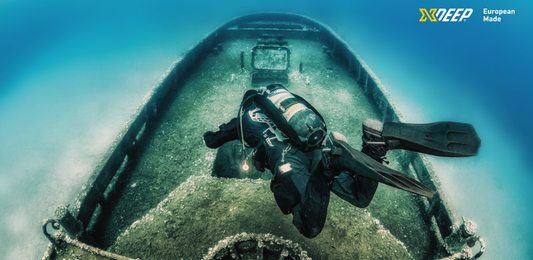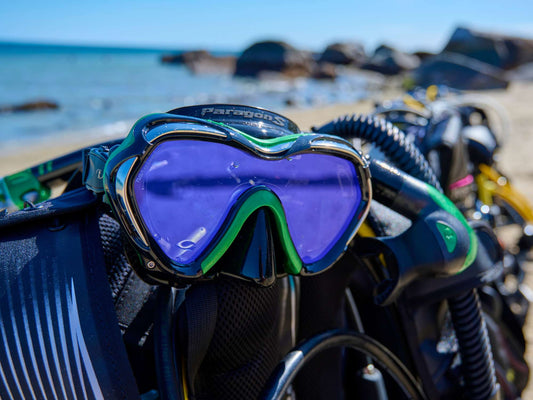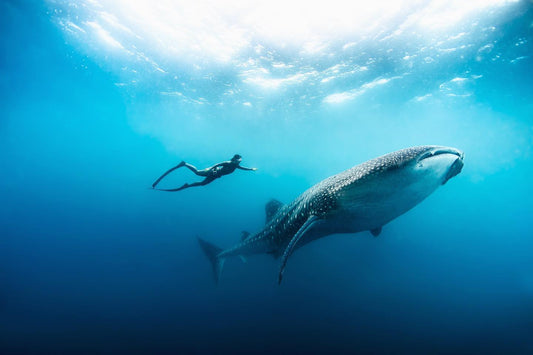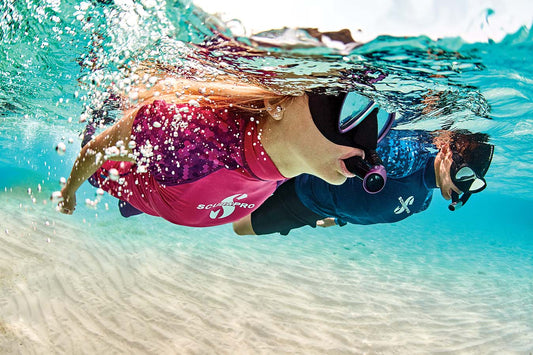Underwater photography is much different than land photography. Light and colour loss, water clarity, currents and housing condensation are all elements that affect underwater photography. The large Dive Certification organizations have complete classes dedicated to Digital Underwater photography. Digital cameras are complex and need to be understood and set properly to obtain best results.
White Balance:
The single most important feature to understand for great underwater photography is White Balance. Adjusting the white balance allows the camera to compensate for water and light conditions. For cameras with Manual White Balance, you should reset every 10 feet of depth. For cameras that do not allow manual white balance, setting White Balance to fluorescent may help. Fluorescent is blue light similar to underwater and the camera will adjust for this. Setting White Balance to low light can also improve results.
Light Loss:
There is much less light underwater than at the surface. Some light is lost immediately as a reflection off the surface of the water. This effect is more pronounced when the sun is low in the sky. Underwater, light is further affected by absorption and scattering. Water absorbs light and turns it into heat. Greater depth means more absorption and less available light. Particles in the water cause light to scatter, further reducing availability.
Colour Loss:
Colour Loss is tied to absorption. When water turns light into heat it absorbs the lowest energy levels first. This means that Reds, Oranges and Yellows are absorbed before Greens and Blues. This why many underwater photos appear greenish blue. It is important to remember that colour loss is affected by total water distance light passes through. This means both depth from the surface AND distance between camera and subject. The greater the TOTAL distance, the greater colour loss.
Blue or Green Photos:
In addition to white balance control, there are several ways to improve colour underwater. The simplest is a red filter. The red filter helps add the red spectrum back into photos. DO NOT use a red filter in shallow water or with a flash: this will cause excessive reds in pictures. An external strobe is another solution. A strobe will add light to provide clear illumination of subject and proper coloration. Do not use a red filter and strobe at the same time or a red filter in less than 20 feet of water. Setting White Balance to fluorescent helps. Fluorescent is blue light similar to underwater and the camera will adjust for this. Setting White Balance to low light can also improve results. Do not use a red filter and strobe at the same time or a red filter in less than 20 feet of water.
Blurry Pictures:
The most common cause of blurry photos is not holding the camera steady. As simple as this sounds, it is much harder to do underwater than on land. Camera and body buoyancy, currents and wave action all affect camera stability. Make sure to squeeze the shutter button with steady pressure. A hard push of the button will cause camera to jerk in your hand-the single most common cause of blurry pictures. If the entire image is blurry, this usually means the camera was not held steady. Another leading cause is incorrect camera settings. With low light underwater, the camera may automatically change the shutter speed (slower) and aperture (larger). This makes the camera extremely susceptible to “shake”. A good mode setting for underwater photography is Sports. In this mode, camera will adjust for faster shutter and smaller aperture size helping enable better results. If you use Auto or Program mode, be sure to set the White Balance for low light or fluorescent. If the subject is blurry but the rest of the picture is sharp, the issue is camera settings and not shake. It is recommended to use Sports mode to photography moving objects underwater.
Spots In The Picture:
This is called backscatter and is usually caused by particles in the water reflecting back from the flash. This will happen with ANY camera that has a flash close to the lens. The flash goes out in a straight beam and particles in the water reflect the light back into the lens, causing spots. The best solution is an external strobe. With a strobe, the light reflects back to the strobe and away from the lens. It is not recommended to use the internal flash underwater. Another helpful item is a flash diffuser. The diffuser will help but will not eliminate backscatter.
Shadow In The Corner Of Photo:
Again caused by internal flash. The housing lens barrel partly blocks the flash and causes the shadow. A flash diffuser will help spread the light from internal flash around the lens barrel. A better option is an external strobe. An external strobe is always recommended for underwater use when more light is required. Use of the internal flash is not recommended underwater.
Slow Capture Time
There are 3 areas which affect the speed of image capture. First the camera must focus, then it takes the image, then it writes the image to memory. Many cameras feature Auto Focus. They must focus prior to actually capturing image. Depressing the shutter button half way will allow camera to pre-focus so it is ready to capture image instantly. Mode selection will affect actual capture speed. Sports Mode, will automatically select faster shutter speeds. Auto, Program, Portrait or Low light modes may slow shutter down.
Condensation:
Digital Cameras create small amounts of heat. These cause the air inside the housing to warm slightly. When it interacts with cold water outside the housing, condensation may form. This is very similar to the fogging inside a cars windshield on a cold night. To minimise condensation: a) avoid opening housing right before dive, especially in humid areas. b) place silica beads pack in housing to absorb moisture. c) use mask defog on lens area of housing. d) Keep the housing out of the sun and try to do pre-dive set up in an air-conditioned or cool room to keep more humid air out of housing.
Shooting Tips:
Try not to shoot upwards towards the surface light as this may cause silhouetting of your subject. It is best to shoot slightly downwards or level to your subject to take advantage of surface light. Shoot lots of images and do your editing on a computer after the dive. Get as close to the subject as possible. Use wide angle format. Experiment with different settings so you can achieve results you like the best.
Care And Storage:
- Rinse the housing thoroughly in fresh water after every dive.
- Dry thoroughly before opening housing.
- Check O-rings prior to every dive to ensure they are clean and free of debris.
- Keep O-rings lightly lubricated with silicone grease.
- Remove batteries from camera for storage.
- Keep the back of housing open to avoid flattening O-rings.
- Store in a cool, dry place.




